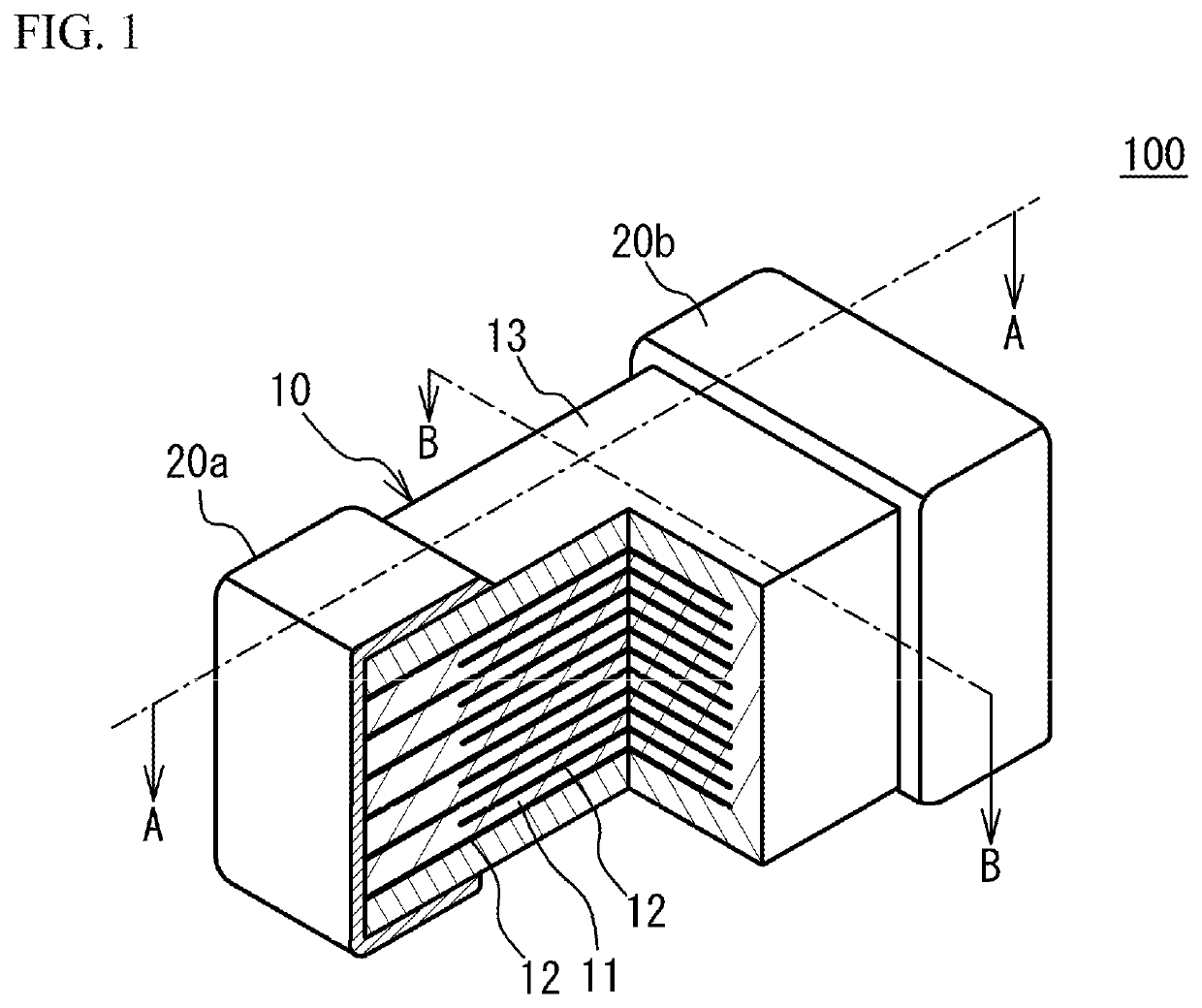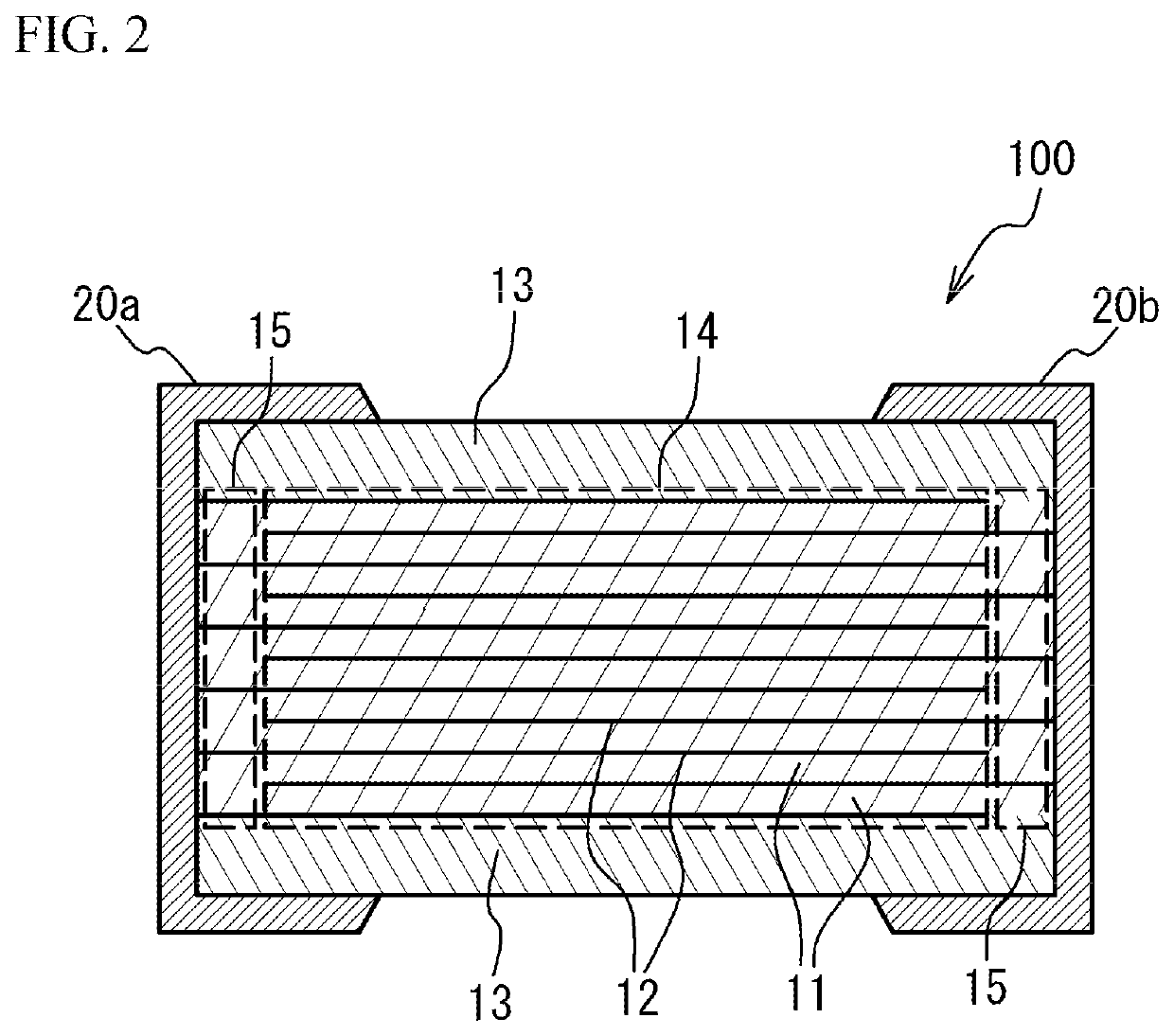Multilayer ceramic capacitor
a multi-layer ceramic and capacitor technology, applied in the field of multi-layer ceramic capacitors, can solve the problem of difficult to suppress the diffusion intrusion of hydrogen in the shape of a proton, and achieve the effect of suppressing the diffusion intrusion of hydrogen
- Summary
- Abstract
- Description
- Claims
- Application Information
AI Technical Summary
Benefits of technology
Problems solved by technology
Method used
Image
Examples
embodiment
[0017]FIG. 1 illustrates a partial perspective view of a multilayer ceramic capacitor 100 in accordance with an embodiment. FIG. 2 illustrates a cross sectional view taken along a line A-A of FIG. 1. FIG. 3 illustrates a cross sectional view taken along a line B-B of FIG. 1. As illustrated in FIG. 1 to FIG. 3, the multilayer ceramic capacitor 100 includes a multilayer chip 10 having a rectangular parallelepiped shape, and a pair of external electrodes 20a and 20b that are respectively provided at two edge faces of the multilayer chip 10 facing each other. In four faces other than the two edge faces of the multilayer chip 10, two faces other than an upper face and a lower face of the multilayer chip 10 in a stacking direction are referred to as side faces. The external electrodes 20a and 20b extend to the upper face, the lower face and the two side faces of the multilayer chip 10. However, the external electrodes 20a and 20b are spaced from each other.
[0018]The multilayer chip 10 has...
first modified embodiment
[0040]Next, a description will be given of a manufacturing method for forming the protective region 17 in the end margin 15. The manufacturing method is different from the above-mentioned method only in the stacking process. Therefore, a description will be given of the different point. A binder such as polyvinyl butyral (PVB) resin, an organic solvent such as ethanol or toluene, and a plasticizer such as dioctyl phthalate (DOP) are added to the resulting ceramic material powder and wet-blended. With use of the resulting slurry, a strip-shaped dielectric green sheet with a thickness of 0.8 μm or less is coated on a base material by, for example, a die coater method or a doctor blade method, and then dried.
[0041]Then, a pattern of the internal electrode layer 12 is provided on the surface of the dielectric green sheet by printing a conductive paste for forming the internal electrode with use of screen printing or gravure printing. The conductive paste includes a powder of the main co...
second modified embodiment
[0046]Next, a description will be given of a manufacturing method for forming the protective region 17 in the side margin 16. A description will be given of the stacking process, as well as the first modified embodiment. A binder such as polyvinyl butyral (PVB) resin, an organic solvent such as ethanol or toluene, and a plasticizer such as dioctyl phthalate (DOP) are added to the resulting ceramic material powder obtained in the making process and wet-blended. With use of the resulting slurry, a strip-shaped dielectric green sheet with a thickness of 0.8 μm or less is coated on a base material by, for example, a die coater method or a doctor blade method, and then dried.
[0047]Then, a pattern of the internal electrode layer 12 is provided on the surface of the dielectric green sheet by printing a conductive paste for forming the internal electrode with use of screen printing or gravure printing. The conductive paste includes a powder of the main component metal of the internal electr...
PUM
| Property | Measurement | Unit |
|---|---|---|
| thickness | aaaaa | aaaaa |
| grain diameter | aaaaa | aaaaa |
| height | aaaaa | aaaaa |
Abstract
Description
Claims
Application Information
 Login to View More
Login to View More - R&D
- Intellectual Property
- Life Sciences
- Materials
- Tech Scout
- Unparalleled Data Quality
- Higher Quality Content
- 60% Fewer Hallucinations
Browse by: Latest US Patents, China's latest patents, Technical Efficacy Thesaurus, Application Domain, Technology Topic, Popular Technical Reports.
© 2025 PatSnap. All rights reserved.Legal|Privacy policy|Modern Slavery Act Transparency Statement|Sitemap|About US| Contact US: help@patsnap.com



